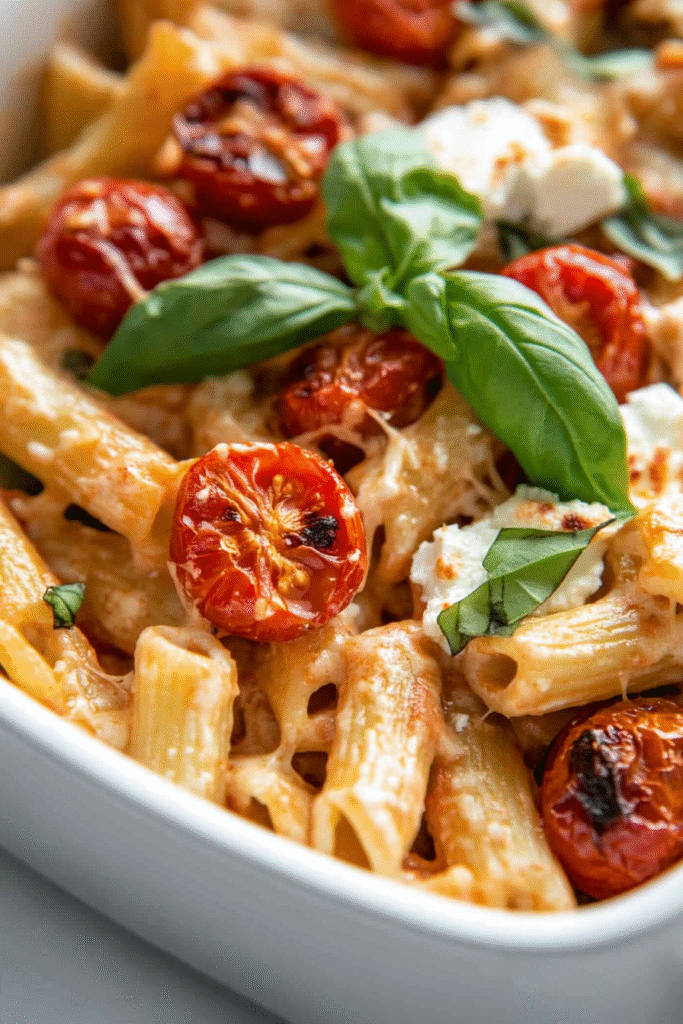Baked Feta Pasta is one of those wonderfully simple yet wildly satisfying recipes that skyrocketed to internet fame for good reason. It’s creamy, tangy, savory, and packed with the natural sweetness of roasted cherry tomatoes. With just a handful of ingredients and minimal prep, this dish delivers maximum flavor and texture. It’s the kind of meal that feels indulgent, but comes together in a refreshingly unfussy way.
In this comprehensive recipe, we’ll break down everything you need to know to master baked feta pasta—from choosing the right type of feta and pasta shapes to troubleshooting common pitfalls like dry sauce or unevenly cooked tomatoes. We’ll explore flavorful add-ins, equipment tips, dietary substitutions, and offer practical storage and reheating advice. Whether you’re new to cooking or a seasoned home chef, this guide will ensure your baked feta pasta turns out perfect every time.
Understanding the Appeal of Baked Feta Pasta
The beauty of baked feta pasta lies in its simplicity and the magical transformation that happens in the oven. As the feta cheese bakes, it softens and develops a creamy texture with a lightly browned, caramelized top. The cherry tomatoes burst and release their juices, creating a fresh, naturally sweet sauce. When stirred together with al dente pasta, the cheese and tomatoes form a velvety coating that clings to each strand.
Part of the dish’s popularity comes from its flexibility. It can easily be adapted to different dietary needs, flavor preferences, or pantry constraints. The base of feta, tomatoes, olive oil, and pasta is a blank canvas for creative variations, making it a versatile recipe that encourages experimentation.

Common Challenges and Troubleshooting Tips
While baked feta pasta is generally very forgiving, a few common challenges can arise:
1. Dry Sauce:
Sometimes, if the tomatoes don’t release enough juice or if the feta is too firm, the sauce can turn out dry. To prevent this, use very ripe cherry or grape tomatoes and be generous with the olive oil. If needed, you can add a splash of reserved pasta water when mixing to loosen the sauce.
2. Overcooked Pasta:
Pasta can quickly go from perfectly al dente to mushy if overcooked. Always cook your pasta a minute or two less than the package instructions, as it will continue to absorb sauce when combined.
3. Uneven Feta Melting:
Not all feta brands melt the same. Look for a block of feta in brine, as it tends to have a creamier texture when baked compared to pre-crumbled versions.
4. Blandness:
Feta and tomatoes provide a solid flavor base, but seasoning is key. Salt, pepper, garlic, and fresh herbs bring brightness and depth. Taste and adjust the seasoning after combining all ingredients.

Choosing the Right Ingredients for Maximum Flavor
Feta Cheese:
- Best Choice: A block of Greek feta in brine. It melts to a luscious, creamy consistency.
- Avoid: Pre-crumbled feta—it contains anti-caking agents and doesn’t melt as well.
Tomatoes:
- Best Choice: Fresh, ripe cherry or grape tomatoes. Their high natural sugar content helps create a sweet, caramelized sauce.
- Avoid: Larger tomatoes with high water content; they won’t provide the same burst of flavor.
Pasta:
- Best Choice: Short pasta shapes like rotini, fusilli, or penne. Their ridges hold the creamy sauce beautifully.
- Avoid: Very delicate pastas like angel hair—they can become over-saturated and lose their structure.
Essential Equipment Recommendations
- Baking Dish: Use an oven-safe dish (ceramic or glass) that snugly fits the block of feta and surrounds it with the tomatoes. An 8×8-inch or similar size is ideal.
- Large Pot: For boiling pasta.
- Fine Mesh Strainer or Colander: To drain pasta quickly and efficiently.
- Sturdy Wooden Spoon or Spatula: Perfect for mixing the sauce and pasta together while gently crushing the tomatoes.
Optional but helpful:
- Microplane or Garlic Press: If you love garlic, a fine mince or grate will integrate it seamlessly into the sauce.
- Zester: For adding lemon zest to brighten the finished dish.
Smart Ingredient Swaps and Creative Additions
Baked feta pasta is wonderfully adaptable. Here are some great substitutions and enhancements:
- Cheese Alternatives: For a milder flavor, try goat cheese or ricotta. For a vegan version, use a plant-based feta substitute.
- Tomato Options: Use cherry, grape, or even small heirloom tomatoes. Canned cherry tomatoes (drained) can work in a pinch.
- Pasta Variations: Gluten-free pasta, whole wheat, or even chickpea pasta are excellent options.
- Add-Ins: Sautéed spinach, roasted zucchini, blistered bell peppers, olives, or artichoke hearts add texture and depth.
- Protein Boosters: Add grilled chicken, shrimp, or chickpeas to make it heartier.
- Flavor Enhancers: A drizzle of balsamic glaze, a sprinkle of chili flakes, or a handful of fresh basil elevates the dish beautifully.
Step-by-Step Preparation Strategy
- Prep Your Ingredients First: Wash the tomatoes, peel the garlic, and bring a pot of salted water to a boil before you start baking. This ensures smooth, stress-free assembly later.
- Choose the Right Baking Dish: Make sure the feta and tomatoes fit snugly but with enough room for heat to circulate.
- Roast Properly: Resist the urge to stir the dish while baking. Let the feta soften and the tomatoes blister undisturbed.
- Cook Pasta Al Dente: Drain it just shy of perfect doneness since it will finish cooking in the sauce.
- Combine with Care: Use a gentle hand when crushing the tomatoes and mixing everything together to preserve texture.
Layering Flavor: Small Touches Make a Big Difference
For all its simplicity, this dish shines with thoughtful seasoning and fresh finishing touches:
- Fresh Garlic: Adding minced garlic after baking (instead of before) retains its brightness and prevents bitterness.
- Lemon Zest and Juice: A touch of lemon adds acidity that balances the richness of the feta.
- Fresh Herbs: Basil, parsley, or oregano provide an herbaceous lift.
- Red Pepper Flakes: Perfect for adding a gentle, warming heat.
- Extra Olive Oil: A finishing drizzle enhances the silky mouthfeel.
Baked Feta Pasta Recipe
Ingredients
For the Pasta:
- 12 ounces (340g) rotini or fusilli pasta
- Salt for pasta water
For the Sauce:
- 1 block (8 ounces / 225g) feta cheese, preferably in brine
- 2 pints (about 600g) cherry or grape tomatoes
- 1/3 cup (80ml) extra virgin olive oil
- 3-4 cloves garlic, minced
- 1/2 teaspoon red pepper flakes (optional)
- Freshly ground black pepper, to taste
Finishing Touches:
- Zest and juice of 1 lemon (optional but recommended)
- Fresh basil leaves, chopped
- Extra olive oil for drizzling
Step-by-Step Instructions
1. Preheat and Prep
Preheat your oven to 400°F (200°C). In a medium-sized oven-safe baking dish, place the block of feta cheese in the center. Scatter the cherry tomatoes evenly around the cheese.
2. Season and Bake
Drizzle the olive oil over the feta and tomatoes, ensuring both are well coated. Sprinkle with freshly ground black pepper and red pepper flakes, if using. Bake uncovered for 30-35 minutes, or until the tomatoes have burst and the feta looks soft and golden on top.
3. Cook the Pasta
While the feta is baking, bring a large pot of salted water to a boil. Cook the pasta until just al dente, about 1-2 minutes less than the package directions. Reserve about 1 cup of pasta water, then drain the pasta.
4. Build the Sauce
Remove the baking dish from the oven. Add the minced garlic directly to the hot dish (the residual heat will mellow the garlic’s sharpness). Using a wooden spoon, gently crush the roasted tomatoes and stir them together with the softened feta to create a creamy sauce. If the mixture seems too thick, add a splash of the reserved pasta water to loosen it to your desired consistency.
5. Combine and Season
Add the cooked pasta to the dish and toss until evenly coated. Taste and adjust seasoning, adding more black pepper or a pinch of salt if needed.
6. Finish with Freshness
Add lemon zest and a squeeze of fresh lemon juice for brightness. Top with freshly chopped basil leaves and an optional drizzle of olive oil for extra silkiness.
7. Serve and Enjoy
Serve immediately while warm and creamy. Garnish with additional herbs or a sprinkle of chili flakes if desired.
Storage, Reheating, and Dietary Notes
- Storage: Keep leftovers in an airtight container in the refrigerator for up to 4 days.
- Reheating: Gently reheat in a saucepan over medium-low heat with a splash of water or olive oil to loosen the sauce. Avoid microwaving if possible, as it can make the pasta rubbery.
- Dietary Substitutions:
- Use gluten-free pasta for a gluten-free version.
- Substitute vegan feta to make this dish plant-based.
- For a lower-carb option, serve the sauce over spiralized zucchini or roasted cauliflower.
Baked Feta Pasta vs. Other Creamy Pasta Dishes
| Feature | Baked Feta Pasta | Alfredo Pasta | Mac and Cheese |
|---|---|---|---|
| Base Sauce | Roasted feta and tomatoes | Heavy cream and Parmesan | Cheese sauce (milk + cheese) |
| Cooking Method | Oven-baked, then combined | Stovetop | Stovetop or baked |
| Texture | Light, creamy, tangy | Rich, buttery, smooth | Creamy, often thicker |
| Common Add-Ins | Fresh herbs, lemon, garlic | Garlic, chicken, broccoli | Breadcrumb topping, bacon |
Frequently Asked Questions
Can I use a different type of cheese?
Yes! While feta is classic, goat cheese, Boursin, or a soft herbed cheese can work well. Each will offer a different flavor profile.
My sauce turned out too thick. What should I do?
Add reserved pasta water, a tablespoon at a time, until the sauce loosens to your liking.
Can I add protein to this dish?
Absolutely. Grilled chicken, shrimp, or even crispy chickpeas can be excellent additions.
Does this dish freeze well?
It’s best enjoyed fresh. The sauce can separate and lose its creamy texture when frozen and thawed.
